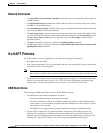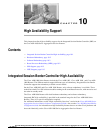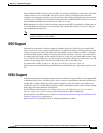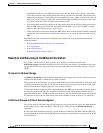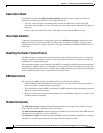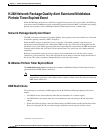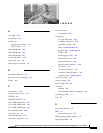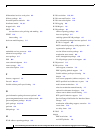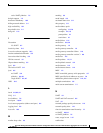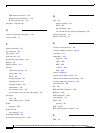
11-3
Cisco IOS XE Integrated Session Border Controller Configuration Guide for the Cisco ASR 1000 Series Aggregation Services Routers
OL-15421-01
Chapter 11 Quality Monitoring and Statistics Gathering
Enhanced Event Notification and Auditing
• If the DBE switched to a new MGC for some reason, the new MGC had no means to learn what
events had occurred on the streams and terminations programmed on the DBE. This behavior was
particularly problematic for the nt/qualert and emp/phtoexp events, which are used to indicate that
media has ceased flowing on a particular stream and can trigger the MGC to delete the context once
all streams within the context reported either of these events.
• If an event notification failed, and the event being notified was not the inactivity timer event (it/ito),
then the DBE did not reset the H.248 association with the MGC. As a result, the MGC could be
unaware that it had failed to process some events.
• Silent gate deletion could occur because the DBE would delete contexts when all streams within the
context had received media-down indications and there was no current H.248 association with an
MGC.
With Enhanced Event Notification and Auditing, these limitations have been minimized with the
following features:
• Retention and Returning of H.248 Event Information
• Association Reset
• Silent Gate Deletion
• Resetting the Media Timeout Timers
Retention and Returning of H.248 Event Information
The storage of H.248 events is always turned on by default. A configuration option (the
h248-event-storage command) enables two modes of H.248 events storage—permanent H.248 events
storage and H.248 events storage until the events are acknowledged by the media gateway controller
(MGC).
Permanent H.248 Event Storage
The h248-event-storage command enables permanent events storage. In this mode, all H.248 events are
retained until the stream on which they occurred is deleted.
These events are stored internally and reported to the SBE using a Notify command. A subsequent audit
of the ObservedEvents descriptor for the stream can be used to return any events that are stored, with
timestamp information indicating when the event actually occurred.
To reduce the memory required to store event information, the DBE only stores the most recent event of
each type for each stream. The only exception is the dd/etd event, which indicates that the end of a
dual-tone multifrequency (DTMF) tone has been detected, and also indicates which tone was detected.
All instances of this event are stored because the entire sequence of tones is likely to be significant.
H.248 Events Storage Until Event Acknowledgment
The system default is the mode where H.248 events are stored only until the events are acknowledged
by the media gateway controller (MGC). This can also be enabled by the no h248-event-storage
command.
H.248 events other than those relating to a media timeout are deleted by the MGC after the MGC has
acknowledged them. In this mode, the H.248 events relating to a media timeout are retained if the H.248
association fails.



